Careem Case Study: E-Business Strategies and Business Models
VerifiedAdded on 2022/09/09
|6
|1314
|20
Case Study
AI Summary
This assignment analyzes the Careem case study, a ride-hailing company operating in the MENA region. The analysis begins with an overview of Careem's business model and market position, followed by an application of Porter's Five Forces framework to assess the competitive landscape in the transportation industry. The analysis highlights the high bargaining power of suppliers (drivers), high buyer power due to low switching costs, and intense industry rivalry with competitors like Uber and local taxi services. The threat of substitutes is considered weak, while the threat of new entrants is high. A SWOT analysis is then presented, identifying Careem's strengths (brand recognition, quality services), weaknesses (driver dependency), opportunities (targeting unorganized markets, increasing internet penetration), and threats (stiff competition, legal factors). The conclusion emphasizes the importance of cost reduction, negotiation with drivers, and strategic promotions for Careem's continued success in a competitive market.
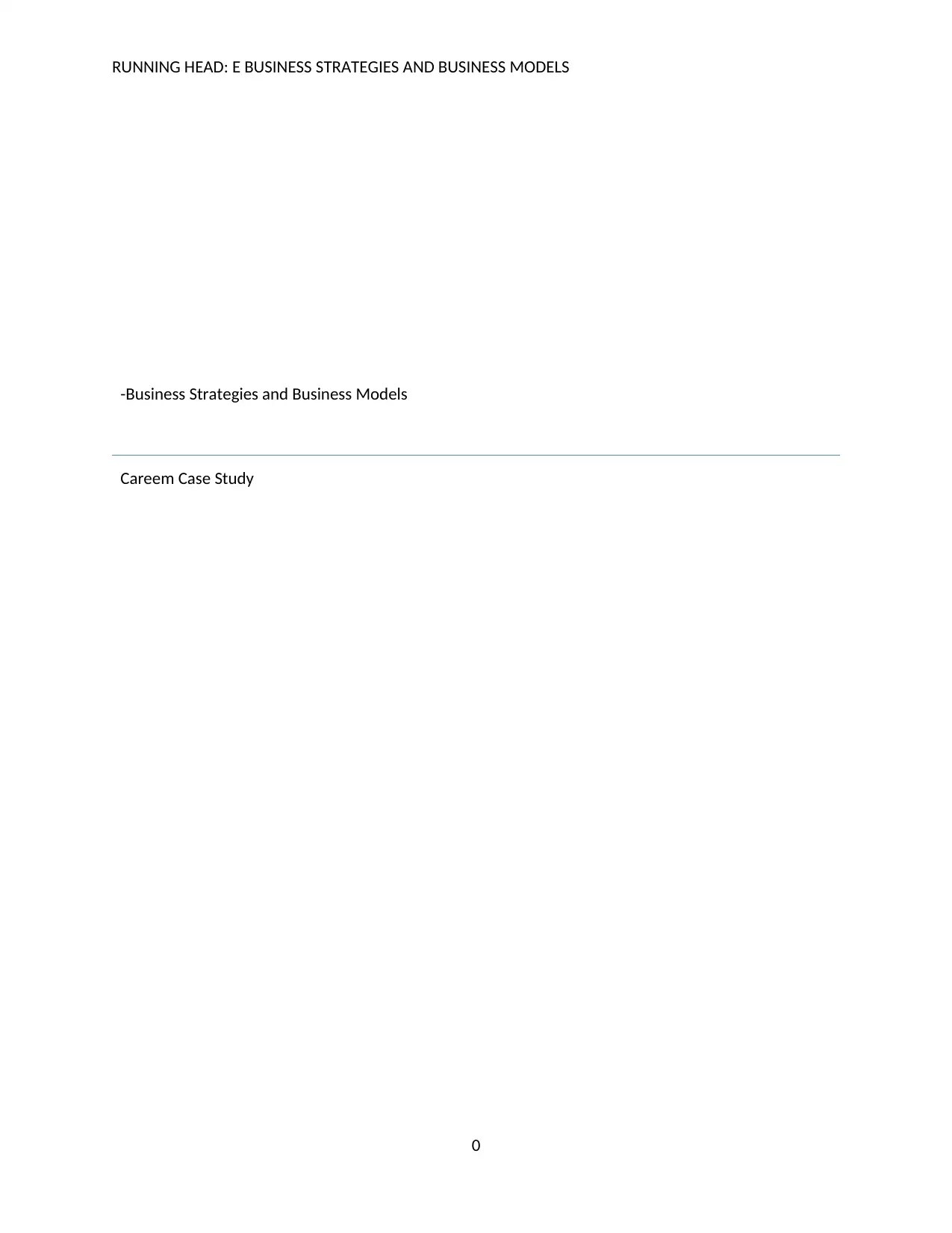
RUNNING HEAD: E BUSINESS STRATEGIES AND BUSINESS MODELS
-Business Strategies and Business Models
Careem Case Study
0
-Business Strategies and Business Models
Careem Case Study
0
Paraphrase This Document
Need a fresh take? Get an instant paraphrase of this document with our AI Paraphraser
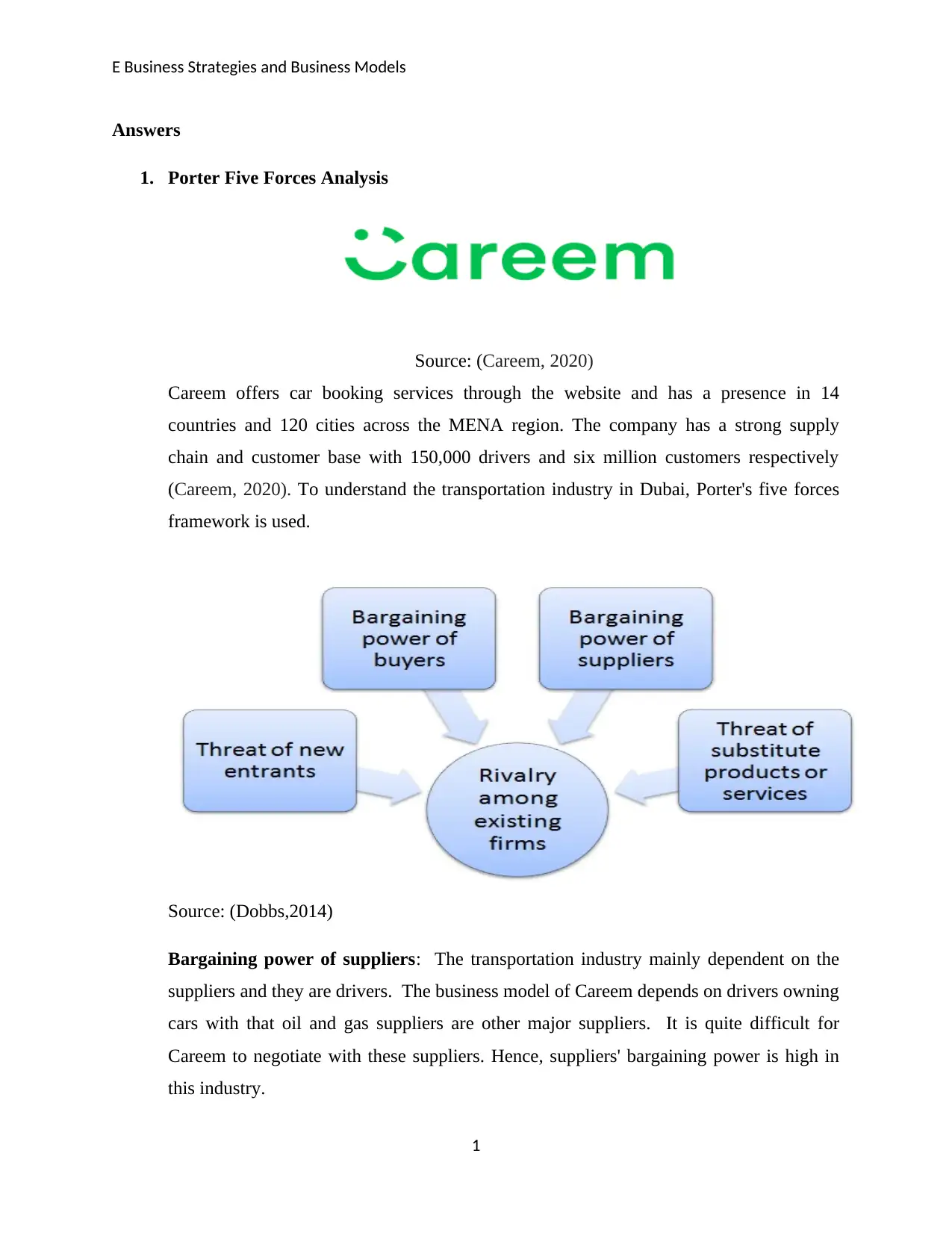
E Business Strategies and Business Models
Answers
1. Porter Five Forces Analysis
Source: (Careem, 2020)
Careem offers car booking services through the website and has a presence in 14
countries and 120 cities across the MENA region. The company has a strong supply
chain and customer base with 150,000 drivers and six million customers respectively
(Careem, 2020). To understand the transportation industry in Dubai, Porter's five forces
framework is used.
Source: (Dobbs,2014)
Bargaining power of suppliers: The transportation industry mainly dependent on the
suppliers and they are drivers. The business model of Careem depends on drivers owning
cars with that oil and gas suppliers are other major suppliers. It is quite difficult for
Careem to negotiate with these suppliers. Hence, suppliers' bargaining power is high in
this industry.
1
Answers
1. Porter Five Forces Analysis
Source: (Careem, 2020)
Careem offers car booking services through the website and has a presence in 14
countries and 120 cities across the MENA region. The company has a strong supply
chain and customer base with 150,000 drivers and six million customers respectively
(Careem, 2020). To understand the transportation industry in Dubai, Porter's five forces
framework is used.
Source: (Dobbs,2014)
Bargaining power of suppliers: The transportation industry mainly dependent on the
suppliers and they are drivers. The business model of Careem depends on drivers owning
cars with that oil and gas suppliers are other major suppliers. It is quite difficult for
Careem to negotiate with these suppliers. Hence, suppliers' bargaining power is high in
this industry.
1
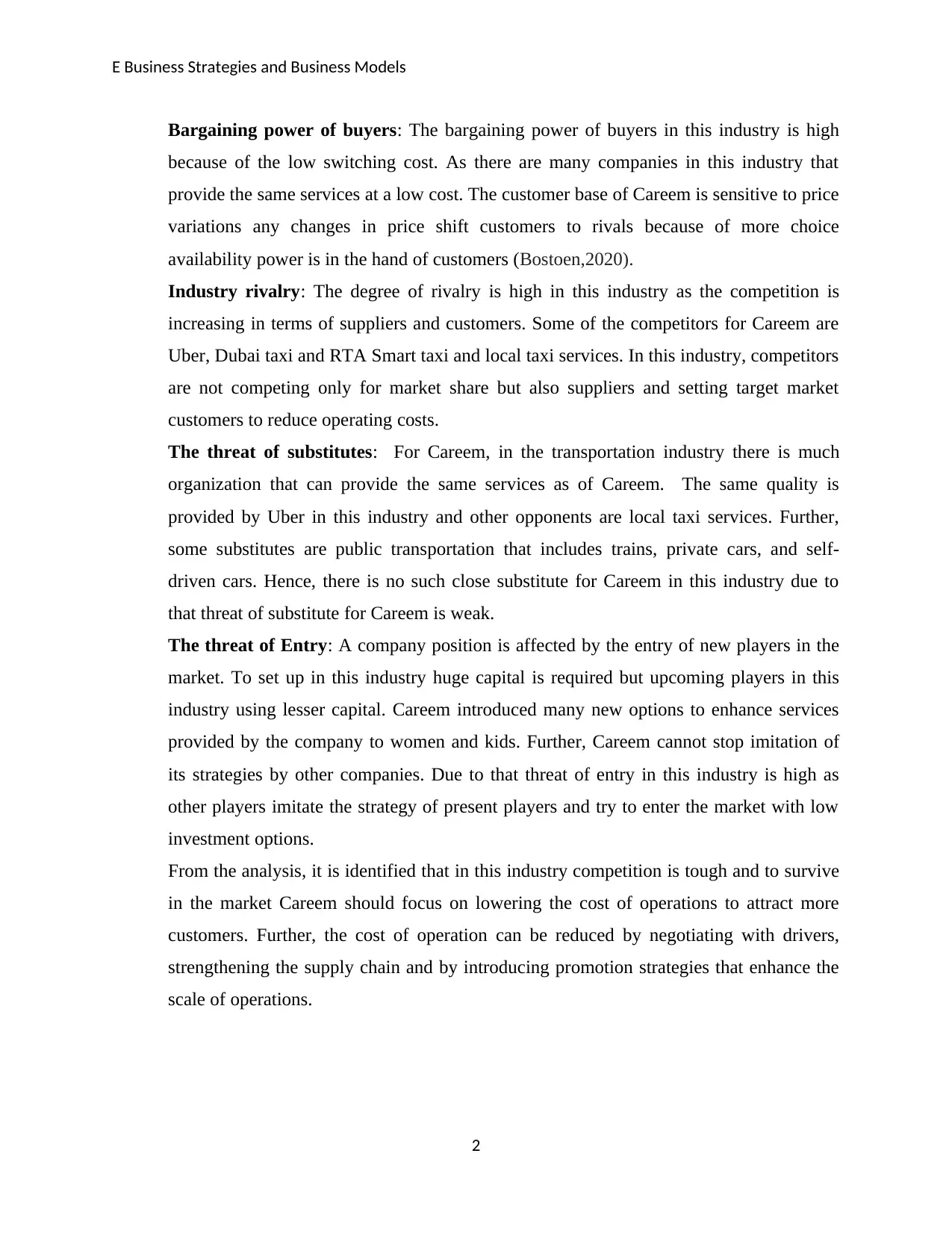
E Business Strategies and Business Models
Bargaining power of buyers: The bargaining power of buyers in this industry is high
because of the low switching cost. As there are many companies in this industry that
provide the same services at a low cost. The customer base of Careem is sensitive to price
variations any changes in price shift customers to rivals because of more choice
availability power is in the hand of customers (Bostoen,2020).
Industry rivalry: The degree of rivalry is high in this industry as the competition is
increasing in terms of suppliers and customers. Some of the competitors for Careem are
Uber, Dubai taxi and RTA Smart taxi and local taxi services. In this industry, competitors
are not competing only for market share but also suppliers and setting target market
customers to reduce operating costs.
The threat of substitutes: For Careem, in the transportation industry there is much
organization that can provide the same services as of Careem. The same quality is
provided by Uber in this industry and other opponents are local taxi services. Further,
some substitutes are public transportation that includes trains, private cars, and self-
driven cars. Hence, there is no such close substitute for Careem in this industry due to
that threat of substitute for Careem is weak.
The threat of Entry: A company position is affected by the entry of new players in the
market. To set up in this industry huge capital is required but upcoming players in this
industry using lesser capital. Careem introduced many new options to enhance services
provided by the company to women and kids. Further, Careem cannot stop imitation of
its strategies by other companies. Due to that threat of entry in this industry is high as
other players imitate the strategy of present players and try to enter the market with low
investment options.
From the analysis, it is identified that in this industry competition is tough and to survive
in the market Careem should focus on lowering the cost of operations to attract more
customers. Further, the cost of operation can be reduced by negotiating with drivers,
strengthening the supply chain and by introducing promotion strategies that enhance the
scale of operations.
2
Bargaining power of buyers: The bargaining power of buyers in this industry is high
because of the low switching cost. As there are many companies in this industry that
provide the same services at a low cost. The customer base of Careem is sensitive to price
variations any changes in price shift customers to rivals because of more choice
availability power is in the hand of customers (Bostoen,2020).
Industry rivalry: The degree of rivalry is high in this industry as the competition is
increasing in terms of suppliers and customers. Some of the competitors for Careem are
Uber, Dubai taxi and RTA Smart taxi and local taxi services. In this industry, competitors
are not competing only for market share but also suppliers and setting target market
customers to reduce operating costs.
The threat of substitutes: For Careem, in the transportation industry there is much
organization that can provide the same services as of Careem. The same quality is
provided by Uber in this industry and other opponents are local taxi services. Further,
some substitutes are public transportation that includes trains, private cars, and self-
driven cars. Hence, there is no such close substitute for Careem in this industry due to
that threat of substitute for Careem is weak.
The threat of Entry: A company position is affected by the entry of new players in the
market. To set up in this industry huge capital is required but upcoming players in this
industry using lesser capital. Careem introduced many new options to enhance services
provided by the company to women and kids. Further, Careem cannot stop imitation of
its strategies by other companies. Due to that threat of entry in this industry is high as
other players imitate the strategy of present players and try to enter the market with low
investment options.
From the analysis, it is identified that in this industry competition is tough and to survive
in the market Careem should focus on lowering the cost of operations to attract more
customers. Further, the cost of operation can be reduced by negotiating with drivers,
strengthening the supply chain and by introducing promotion strategies that enhance the
scale of operations.
2
⊘ This is a preview!⊘
Do you want full access?
Subscribe today to unlock all pages.

Trusted by 1+ million students worldwide
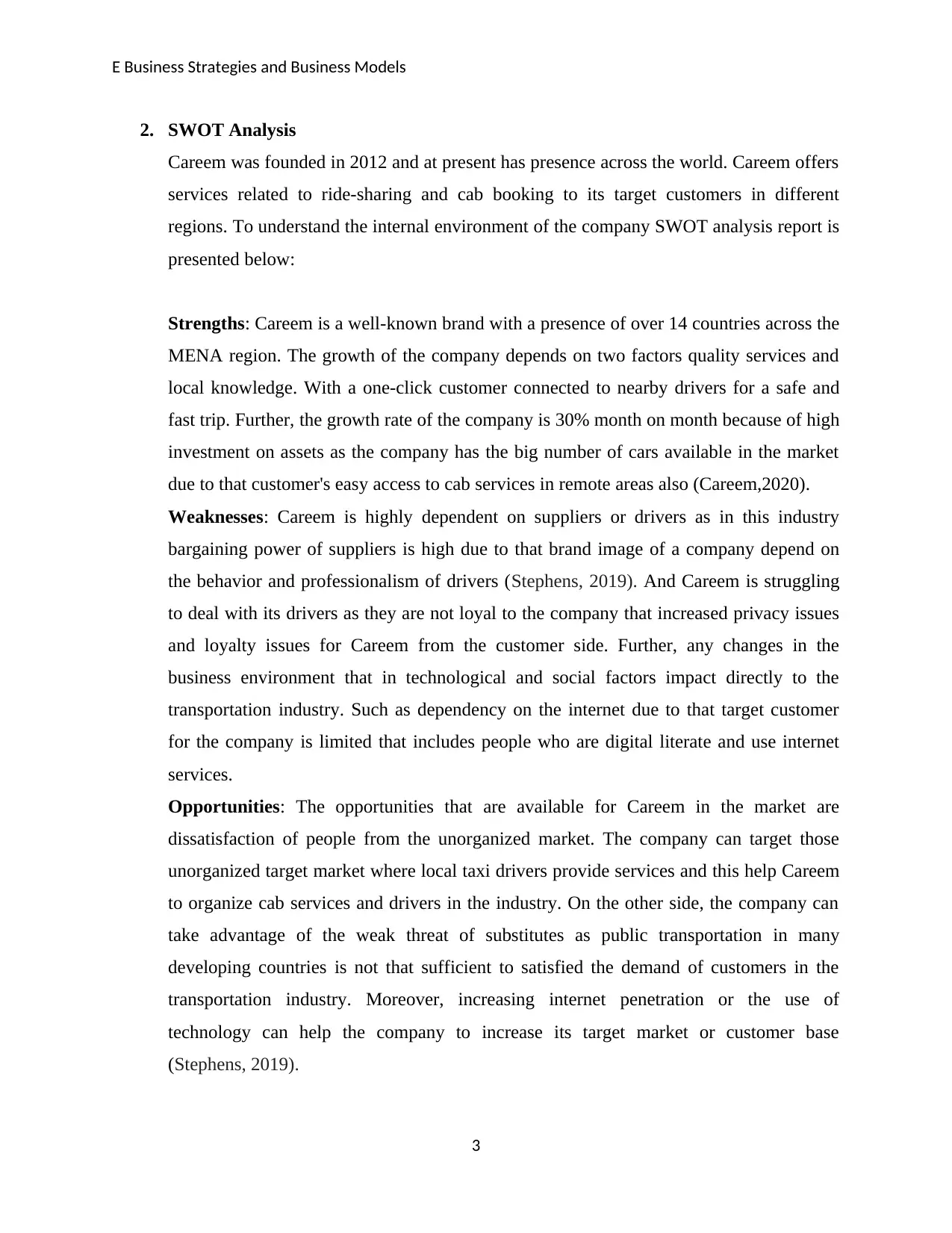
E Business Strategies and Business Models
2. SWOT Analysis
Careem was founded in 2012 and at present has presence across the world. Careem offers
services related to ride-sharing and cab booking to its target customers in different
regions. To understand the internal environment of the company SWOT analysis report is
presented below:
Strengths: Careem is a well-known brand with a presence of over 14 countries across the
MENA region. The growth of the company depends on two factors quality services and
local knowledge. With a one-click customer connected to nearby drivers for a safe and
fast trip. Further, the growth rate of the company is 30% month on month because of high
investment on assets as the company has the big number of cars available in the market
due to that customer's easy access to cab services in remote areas also (Careem,2020).
Weaknesses: Careem is highly dependent on suppliers or drivers as in this industry
bargaining power of suppliers is high due to that brand image of a company depend on
the behavior and professionalism of drivers (Stephens, 2019). And Careem is struggling
to deal with its drivers as they are not loyal to the company that increased privacy issues
and loyalty issues for Careem from the customer side. Further, any changes in the
business environment that in technological and social factors impact directly to the
transportation industry. Such as dependency on the internet due to that target customer
for the company is limited that includes people who are digital literate and use internet
services.
Opportunities: The opportunities that are available for Careem in the market are
dissatisfaction of people from the unorganized market. The company can target those
unorganized target market where local taxi drivers provide services and this help Careem
to organize cab services and drivers in the industry. On the other side, the company can
take advantage of the weak threat of substitutes as public transportation in many
developing countries is not that sufficient to satisfied the demand of customers in the
transportation industry. Moreover, increasing internet penetration or the use of
technology can help the company to increase its target market or customer base
(Stephens, 2019).
3
2. SWOT Analysis
Careem was founded in 2012 and at present has presence across the world. Careem offers
services related to ride-sharing and cab booking to its target customers in different
regions. To understand the internal environment of the company SWOT analysis report is
presented below:
Strengths: Careem is a well-known brand with a presence of over 14 countries across the
MENA region. The growth of the company depends on two factors quality services and
local knowledge. With a one-click customer connected to nearby drivers for a safe and
fast trip. Further, the growth rate of the company is 30% month on month because of high
investment on assets as the company has the big number of cars available in the market
due to that customer's easy access to cab services in remote areas also (Careem,2020).
Weaknesses: Careem is highly dependent on suppliers or drivers as in this industry
bargaining power of suppliers is high due to that brand image of a company depend on
the behavior and professionalism of drivers (Stephens, 2019). And Careem is struggling
to deal with its drivers as they are not loyal to the company that increased privacy issues
and loyalty issues for Careem from the customer side. Further, any changes in the
business environment that in technological and social factors impact directly to the
transportation industry. Such as dependency on the internet due to that target customer
for the company is limited that includes people who are digital literate and use internet
services.
Opportunities: The opportunities that are available for Careem in the market are
dissatisfaction of people from the unorganized market. The company can target those
unorganized target market where local taxi drivers provide services and this help Careem
to organize cab services and drivers in the industry. On the other side, the company can
take advantage of the weak threat of substitutes as public transportation in many
developing countries is not that sufficient to satisfied the demand of customers in the
transportation industry. Moreover, increasing internet penetration or the use of
technology can help the company to increase its target market or customer base
(Stephens, 2019).
3
Paraphrase This Document
Need a fresh take? Get an instant paraphrase of this document with our AI Paraphraser
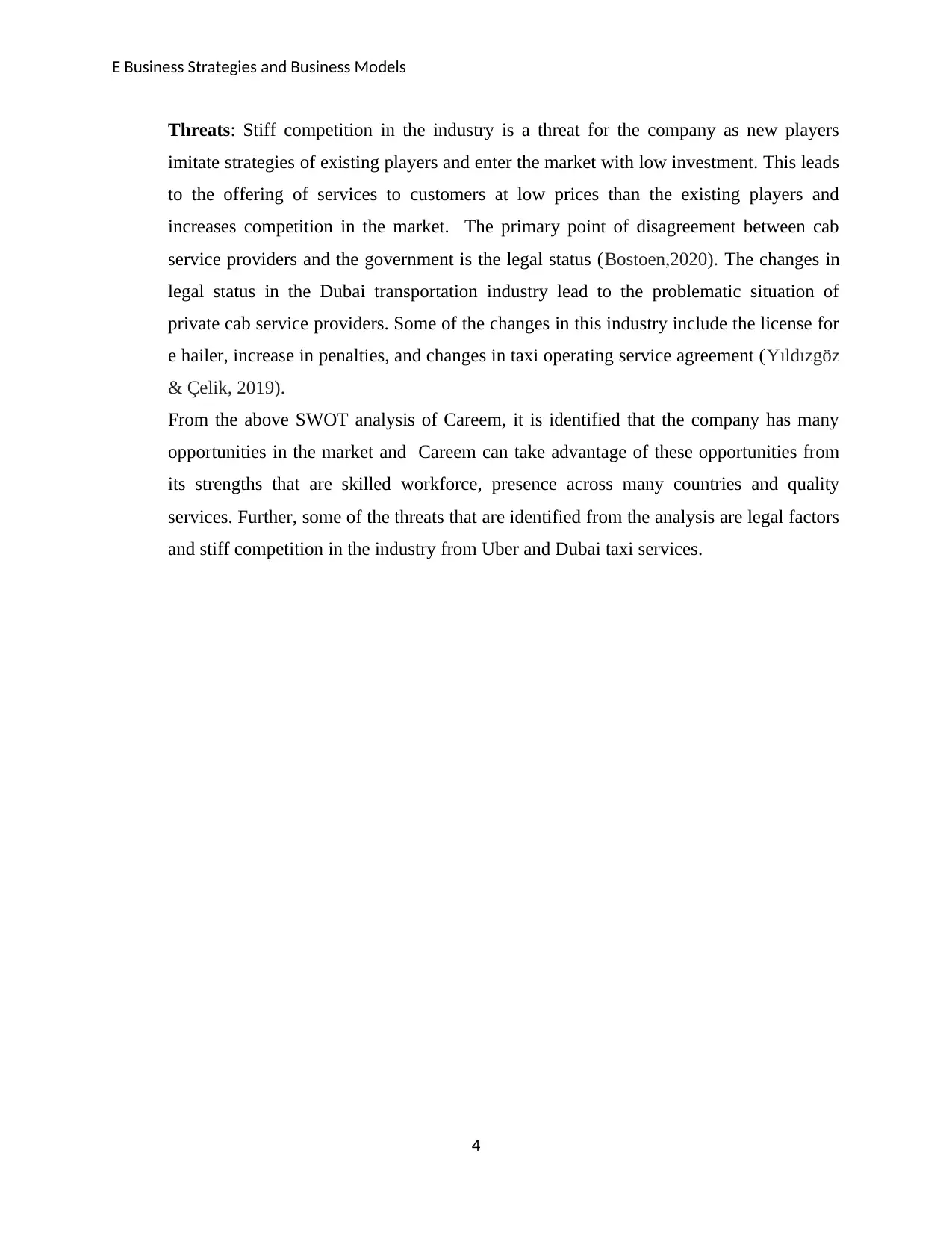
E Business Strategies and Business Models
Threats: Stiff competition in the industry is a threat for the company as new players
imitate strategies of existing players and enter the market with low investment. This leads
to the offering of services to customers at low prices than the existing players and
increases competition in the market. The primary point of disagreement between cab
service providers and the government is the legal status (Bostoen,2020). The changes in
legal status in the Dubai transportation industry lead to the problematic situation of
private cab service providers. Some of the changes in this industry include the license for
e hailer, increase in penalties, and changes in taxi operating service agreement (Yıldızgöz
& Çelik, 2019).
From the above SWOT analysis of Careem, it is identified that the company has many
opportunities in the market and Careem can take advantage of these opportunities from
its strengths that are skilled workforce, presence across many countries and quality
services. Further, some of the threats that are identified from the analysis are legal factors
and stiff competition in the industry from Uber and Dubai taxi services.
4
Threats: Stiff competition in the industry is a threat for the company as new players
imitate strategies of existing players and enter the market with low investment. This leads
to the offering of services to customers at low prices than the existing players and
increases competition in the market. The primary point of disagreement between cab
service providers and the government is the legal status (Bostoen,2020). The changes in
legal status in the Dubai transportation industry lead to the problematic situation of
private cab service providers. Some of the changes in this industry include the license for
e hailer, increase in penalties, and changes in taxi operating service agreement (Yıldızgöz
& Çelik, 2019).
From the above SWOT analysis of Careem, it is identified that the company has many
opportunities in the market and Careem can take advantage of these opportunities from
its strengths that are skilled workforce, presence across many countries and quality
services. Further, some of the threats that are identified from the analysis are legal factors
and stiff competition in the industry from Uber and Dubai taxi services.
4
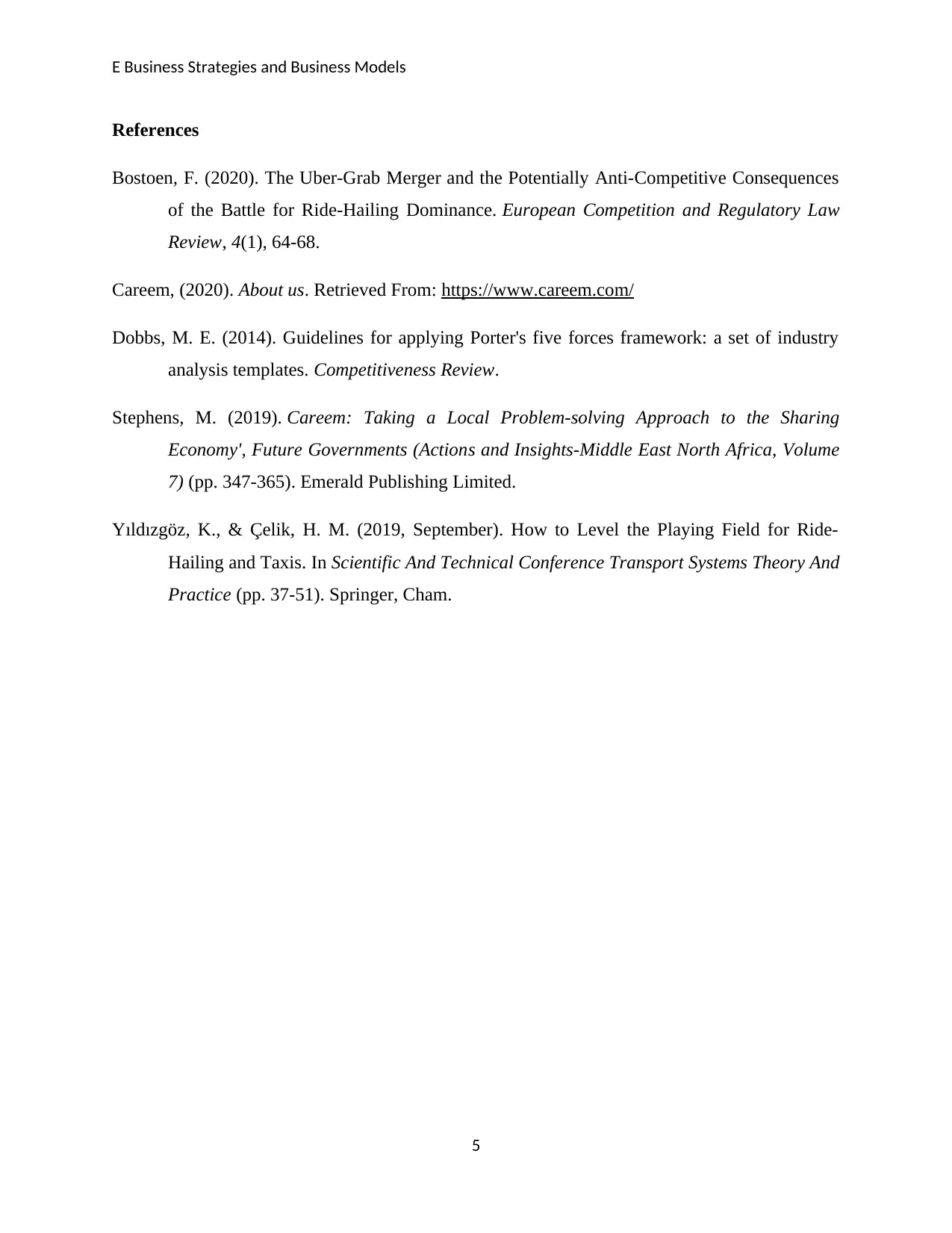
E Business Strategies and Business Models
References
Bostoen, F. (2020). The Uber-Grab Merger and the Potentially Anti-Competitive Consequences
of the Battle for Ride-Hailing Dominance. European Competition and Regulatory Law
Review, 4(1), 64-68.
Careem, (2020). About us. Retrieved From: https://www.careem.com/
Dobbs, M. E. (2014). Guidelines for applying Porter's five forces framework: a set of industry
analysis templates. Competitiveness Review.
Stephens, M. (2019). Careem: Taking a Local Problem-solving Approach to the Sharing
Economy', Future Governments (Actions and Insights-Middle East North Africa, Volume
7) (pp. 347-365). Emerald Publishing Limited.
Yıldızgöz, K., & Çelik, H. M. (2019, September). How to Level the Playing Field for Ride-
Hailing and Taxis. In Scientific And Technical Conference Transport Systems Theory And
Practice (pp. 37-51). Springer, Cham.
5
References
Bostoen, F. (2020). The Uber-Grab Merger and the Potentially Anti-Competitive Consequences
of the Battle for Ride-Hailing Dominance. European Competition and Regulatory Law
Review, 4(1), 64-68.
Careem, (2020). About us. Retrieved From: https://www.careem.com/
Dobbs, M. E. (2014). Guidelines for applying Porter's five forces framework: a set of industry
analysis templates. Competitiveness Review.
Stephens, M. (2019). Careem: Taking a Local Problem-solving Approach to the Sharing
Economy', Future Governments (Actions and Insights-Middle East North Africa, Volume
7) (pp. 347-365). Emerald Publishing Limited.
Yıldızgöz, K., & Çelik, H. M. (2019, September). How to Level the Playing Field for Ride-
Hailing and Taxis. In Scientific And Technical Conference Transport Systems Theory And
Practice (pp. 37-51). Springer, Cham.
5
⊘ This is a preview!⊘
Do you want full access?
Subscribe today to unlock all pages.

Trusted by 1+ million students worldwide
1 out of 6
Related Documents
Your All-in-One AI-Powered Toolkit for Academic Success.
+13062052269
info@desklib.com
Available 24*7 on WhatsApp / Email
![[object Object]](/_next/static/media/star-bottom.7253800d.svg)
Unlock your academic potential
Copyright © 2020–2025 A2Z Services. All Rights Reserved. Developed and managed by ZUCOL.





